Background:
In Hodgkin's disease accurate restaging is important to assess treatment results and may eventually provide a basis for further therapeutic strategies. A typical dilemma after treatment of Hodgkin's disease with radiographically persistent lymphoma is the differentiation between sterilized residual mass and viable tumor. Positron emission tomography (PET) has been described as a reliable tool to identify active lymphoma. Aim of the present study was to assess the accuracy and clinical relevance of PET for treatment control and in the situation of a suspected relapse of Hodgkin's disease.
Patients and Methods: 63 patients (32 men, 31 women, mean age 41.5 years) with Hodgkin's disease were investigated with FDG-PET. In 51 Patients 63 PET studies were performed as a treatment control (group 1) after primary therapy. 17 patients (5 of whom preexamined in group 1) underwent 18 PET scans for confirmation of suspected relapse (group 2). PET was performed with a dedicated whole-body ring scanner. In a retrospective analysis, all FDG-PET scans were compared with conventional imaging methods and related to the final diagnosis obtained by histology and/or clinical follow-up (mean 22.4 months).
Results: Group 1: FDG-PET showed an accuracy of 91%, whereas the accuracy of conventional imaging was 62%. Group 2: The accuracy for PET was 83% and 56% for conventional imaging.
Conclusion: The present data suggest that PET is a sensitive and reliable tool for detection of involved areas of active Hodgkin's disease. The accuracy of PET for restaging purpose seems to be superior than conventional imaging.
Hintergrund:
Ein akkurates Restaging ist nach Primärtherapie ein Morbus Hodgkin von besonserer Bedeutung für die Einschätzung des Therapieerfolgs und eventuelle Festlegung weiterer Behandlungsmaßnahmen. Häufig besteht das Problem, bei röntgenmorphologisch fortbestehender Raumforderung zwischen sterilisiertem Resttumor und aktivem Lymphom zu unterscheiden. Für diese Situation wird die Positronenemissionstomographie (PET) als zuverlässige Methode zur Detektion aktiver Lymphommanifestationen beschrieben. Ziel der vorliegenden Studie war es, Zuverlässigkeit (accuracy) und klinische Relevanz von PET in der Therapiekontrolle und bei Verdacht auf Rezidiv zu evaluieren.
Patienten und Methode: Insgesamt wurden 63 Patienten (32 Männer, 31 Frauen, Durchschnittsalter 41,5 Jahre) untersucht. Bei 51 Patienten wurden 63 PET-Scans nach Primärbehandlung zur Therapiekontrolle (Gruppe 1) durchgeführt, bei 17 Patienten (davon fünf in Gruppe 1 voruntersucht) erfolgten 18 PET-Untersuchungen zur Abklärung bei Verdacht auf Rezidiv. Die PET wurde mit einem Ganzkörper-Vollring-Scanner durchgeführt. Alle PET-Befunde wurden in einer retrospektiven Analyse mit denen radiologischer bzw. kernspintomographischer Untersuchungen verglichen und mit der endgültigen Diagnose auf der Basis histologischer Befunde und/oder des klinischen Verlaufs korreliert.
Resultate: Gruppe 1: Die Zuverlässigkeit von FDG-PET lag bei 91%, die der herkönnlichen Bildgebung (CT, MR) bei 62%. Gruppe 2: Hier zeigte PET eine Zuverlässigkeit von 83% im Gegensatz zu herkömmlichen bildgebenden Verfahren mit 56%.
Schlussfolgerung: PET erscheint anhand der vorgestellten Daten als empfindliche und zuverlässige Methode zur Darstellung von aktiven Lymphommanifestationen. Die Zuverlässigkeit von PET im Restaging des Morbus Hodgkin zeigte sich der der herkömmlichen Bildgebung als üerlegen.
Similar content being viewed by others
Author information
Authors and Affiliations
Additional information
Received: June 19, 2000; accepted: September 22, 2000
Rights and permissions
About this article
Cite this article
Lang, O., Bihl, H., Hültenschmidt, B. et al. Clinical Relevance of Positron Emission Tomography (PET) in Treatment Control and Relapse of Hodgkin's Disease. Strahlenther Onkol 177, 138–144 (2001). https://doi.org/10.1007/PL00002394
Issue Date:
DOI: https://doi.org/10.1007/PL00002394




